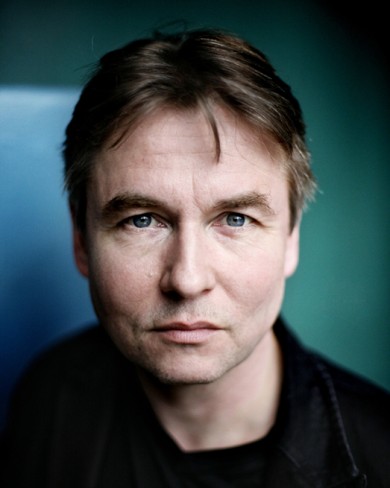Salonen delivers an electrifying, memorable evening with New World Symphony

Esa-Pekka Salonen led the New World Symphony Saturday night in music of Debussy, Salonen and Stravinsky. Photo: Katja Tähjä
There could be no better fulfillment of the New World Symphony’s mission of being America’s orchestral academy than Saturday night’s program featuring Stravinsky’s Firebird, which brought superstar Finnish conductor-composer Esa-Pekka Salonen to guide the outstanding young musicians in a spectacular performance few major orchestras could match.
Principal conductor and artistic director of the Philharmonia Orchestra in London, Salonen is well known in the U.S. for his nearly twenty-year tenure at the Los Angeles Philharmonic, which he transformed into one of the most vibrant of today’s national orchestras.
Salonen lived up to the hype in his New World Symphony debut, conducting with a fluid, graceful surety that was mesmerizing. Opening with Claude Debussy’s Prelude to the Afternoon of a Faun, Salonen used just his open hands, fingers gracefully expressive, to stretch phrases languidly or cue the most delicate pizzicato. In turn, the orchestra responded to Salonen’s every elegant gesture in a bravura performance. Seth Morris’s exquisite flute solos were matched in flawless intonation of the tutti winds. The horns, featured prominently in the work, were soft and buttery, perfectly balanced, and consistently musical. A warm silkiness in the strings replaced the usually feathery sound of impressionist music, no less delicate, but adding welcome dimension to the texture. The masterful performance received a curtain call, setting high expectations for the remainder of the concert.
Salonen’s own Nyx followed. Premiered in 2011—the same year he received the Grawemeyer Award, one of composition’s top international honors—Salonen describes Nyx as a “Greek goddess of the first rank, primordial, a daughter of Gaia who was born out of chaos.” Little is known about Nyx, which fascinates Salonen, who imagines her as a “totally elusive figure, sort of capricious,” for whom he writes equally capricious music.
A horn player himself, Salonen places tremendous demands upon the section, calling it a concertante for horns and clarinets. Horns are nearly always playing, opening the work, expanding from unison to heterophonic activity and back, expertly colored by vibes and harp. These expanding unisons quickly spread throughout the orchestra, building timbral richness that gives way to powerful melodic lines in the strings and clarinets, followed by an eruption in the brass. This power swiftly changes to exposed clarinet melodies over shimmering, glittering strings with pizzicato bass and celesta, a sound Salonen describes as “a kind of flicker which I associated with mythology and divine things.” The two ideas, clearly sculpted throughout the work, propel it constantly forward, occasionally through dense counterpoint, always deftly maneuvered by Salonen himself.
Last on the program was Igor Stravinsky’s celebrated 1910 ballet, The Firebird, performed complete. Salonen’s conducting style, this time with baton, is so intriguing to watch that his nearly imperceptible beat in the incredibly restrained opening passage for double basses added a breathtakingly dramatic effect. The tremendously quiet opening, while thrilling, left little support for the trombone and wind entrances that followed, which seemed overexposed by comparison.
Otherwise, Salonen’s dynamic extremes and skill at exploring the nuances of timbre served the work well, and when the strings were finally unleashed, they were electrifying. From their entrances in the “Dance of the Firebird,” flutist Melanie Lançon and oboist Jennifer Christen perfectly captured the wild, mystical quality of the character, so seamlessly and timbrally unified that it seemed effortless. Colin Asher Sutliff’s horn solo ushering in the finale was equally impressive, all the more so after the workout of the preceding works for the section.
Through it all, Salonen’s energy never flagged, embodying the music and taking risks, most impressively his stunning use of silence at the “Sudden Appearance of Prince Ivan.” In turn, the musicians left everything they had on the stage, a gift given and a gift received. Four curtain calls rewarded their efforts.
Posted in Performances
5 Responses to “Salonen delivers an electrifying, memorable evening with New World Symphony”
Leave a Comment
Sun Apr 8, 2012
at 12:22 pm
5 Comments







Posted Apr 09, 2012 at 12:18 pm by claude elbaz
amazing evening ……thank you
Posted Apr 09, 2012 at 1:26 pm by Kristian Toimil
Four curtain calls well deserved! It was another spectacular night at the NWC. I adored the manner in which, right at the finale, when the orchestra lets go one final blast of music, Salonen literally crouched down and with his hands lifted the music to its wonderous conclusion.
Afterwards, I wondered to myself, why we never hear the NWS on programs like SymphonyCast or Performance Today. I mean, this was a great concert led by one of the best composers today. The world should be able to hear this performance!
Posted Apr 09, 2012 at 2:35 pm by Chris Ingalls
one of the best concerts i have ever seen by nws
Posted Apr 10, 2012 at 9:37 am by Dave R.
I agree with all of the above. The New World is always good, sometimes great, but they were sensational Saturday. My wife compared it to the difference between good risotto and creamy risotto; creamy risotto Saturday night!
Posted Apr 10, 2012 at 11:18 am by Larry McCaffrey
Sunday’s NY Times Arts section contained a very informative review (to me at least) of how the gestures and posture of the director interact and lead the orchestra, including illustrations. Thinking back to Salonen’s direction Saturday evening and having the benefit of sitting in a side seat almost facing Salonen, it was wonderful experience to feel a director’s impact from the musician perspective in what was a wonderful and emotive performance, especially Salonen’s exuberant facial expression pulling all from his orchestra in the Firebird conclusion.